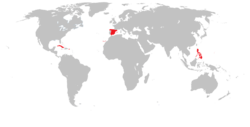Kingdom of Spain Reino de España | |||||||||
|---|---|---|---|---|---|---|---|---|---|
| 1833–1868 | |||||||||
| Anthem: Marcha Real | |||||||||
 | |||||||||
| Capital | Madrid | ||||||||
| Government | Unitary parliamentary constitutional monarchy | ||||||||
| History | |||||||||
| 1833 | |||||||||
| 1868 | |||||||||
| ISO 3166 code | ES | ||||||||
| |||||||||
The reign of Isabella II has been seen as being essential to the modern history of Spain. Isabella's reign spanned the death of Ferdinand VII in 1833 until the Spanish Glorious Revolution of 1868, which forced the Queen into exile and established a liberal state in Spain.[1]
After the death of Ferdinand VII on 29 September 1833, his wife Maria Christina of the Two Sicilies assumed the regency with the support of the liberals, on behalf of their daughter Isabella. Conflict with her brother-in-law, Carlos María Isidro de Borbón, who aspired to the throne by virtue of a supposedly valid Salic Law – already repealed by Carlos IV and Ferdinand VII himself – led the country into the First Carlist War.[2]
After the brief regency of Espartero, which succeeded the regency of María Cristina de Borbón-Dos Sicilias, Isabella II was proclaimed of age at the age of thirteen by resolution of the Cortes Generales[3] in 1843. Thus began the effective reign of Isabella II, which is usually divided into four periods: the moderate decade (1844–1854); the progressive biennium (1854–1856); the period of the Liberal Union governments (1856–1863) and the final crisis (1863–1868).[citation needed]
The reign of Isabella II was characterized by an attempt to modernize Spain which was contained, by the internal tensions of the liberals, the pressure that continued to be exerted by the supporters of more or less moderate absolutism, the governments totally influenced by the military establishment and the final failure in the face of the economic difficulties and the decline of the Liberal Union which led Spain into the experience of the Democratic Sexenio. Her reign was greatly influenced by the personality of Queen Isabella, who had no gifts for government and was under constant pressure from the Court, especially from her own mother, and also from Generals Ramón María Narváez, Baldomero Espartero and Leopoldo O'Donnell, which prevented the transition from the Old Regime to the Liberal State from being consolidated, and Spain reached the last third of the 19th century in unfavorable conditions compared to other European powers.[4]
The reign of Isabella II was divided into two major stages:
- Her minority reign (1833–1843), during which the regency of Spain was assumed first by her mother Maria Christina of the Two Sicilies and later by general Baldomero Espartero. Upon the death of Ferdinand VII on 29 September 1833, his wife, Maria Christina of the Two Sicilies assumed the regency with the support of the liberals, in the name of her daughter and future queen, Isabella II. The conflict with her brother-in-law, Infante Carlos, Count of Molina, who aspired to the throne in virtue of the presumed validity of Salic law—which had been abolished by Charles IV and ignored by Ferdinand VII—brought the nation into the First Carlist War.[1]
- Her true reign (1843–1868), which began with the declaration of the Cortes Generales that her majority reign was to begin when she was thirteen years old. This period can also be subdivided in following periods:

- 1844–1854: The Moderate decade (Década moderada), a period of conservative retrenchment under the Moderate Party after the passing of the progressive constitution of 1837.
- 1854–1856: The progressive two years (Bienio progresista), following the unrest of the Vicalvarada, as the Progressive Party attempted to implement the reformist Manzanares manifesto.
- 1856–1868: The Liberal Union period, as the Liberal Union government, a centrist coalition, tried to maintain a balance between the two positions
- 1868: The crisis (La Gloriosa) and downfall of Queen Isabella, led to her exile to France.
- ^ a b Historia de España. Carr, Raymond., Gil Aristu, José Luis. Barcelona: Ediciones Península. 2001. ISBN 84-8307-337-4. OCLC 46599274.
{{cite book}}: CS1 maint: others (link) - ^ Vilches García, Jorge. (2001). Progreso y libertad : el Partido Progresista en la revolución liberal española. Madrid: Alianza Editorial. pp. 37–38. ISBN 84-206-6768-4. OCLC 48638831.
- ^ http://www.cortesgenerales.es/ [bare URL]
- ^ "Collections Online | British Museum". www.britishmuseum.org. Retrieved 25 September 2022.

